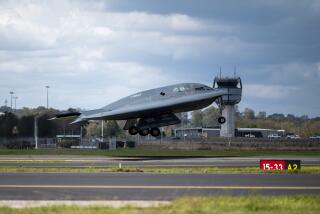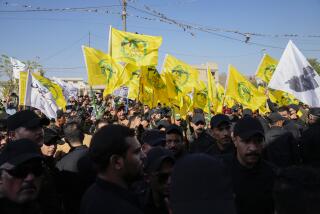U.S. Copters That Attacked Iranian Ship Are Swift, Silent and Secret
WASHINGTON — The U.S. helicopters that attacked the Iranian ship laying mines in the Persian Gulf are part of a top-secret unit created to support the Army’s Special Operations Forces, Pentagon officials and sources said Thursday.
The copters, known as MH-6s, are two-man, light observation aircraft attached to a reinforced assault aviation battalion known as Task Force 160, part of the Army’s Special Operations Command based at Ft. Campbell, Ky.
Before this week, Task Force 160 had seen combat only once--during the 1983 U.S. invasion of the Caribbean island of Grenada.
In its current form, Task Force 160 is made up of about 900 men, with roughly 75 helicopters of at least three types. Its training consists of perfecting the equipment and tactics needed to perform one of the most difficult jobs in all of aviation--flying a helicopter in the dead of night, at top speed, at tree-top level.
Two months ago, reports surfaced that the task force had been given a new role--supporting the Navy’s Middle East Force in the Persian Gulf.
On Monday night, after days of covert surveillance, the two Army helicopters lifted off the frigate Jarrett and began stalking the Iran Ajr, a landing craft that American intelligence was convinced was being used to plant mines in the gulf.
Shortly before 11 p.m. local time, the copters confirmed that mines were being dropped over the side of the Iranian vessel.
With one helicopter serving as a spotter and back-up, the second moved in and sprayed the Iran Ajr with cannon fire from its 7.62-millimeter machine guns. The Iranians stopped dropping mines--for a short time.
Half an hour later, however, the copter crews reported the Iranian vessel had resumed sowing mines. This time, as Rear Adm. Harold J. Bernsen of the Middle East Force would later describe it, “we used additional force.”
The copters moved in with a vengeance, opening up not only with their machine guns but also 2.75-inch rockets. In seconds, the Iranian ship was dead in the water. A fire had erupted on the ship’s fantail, and five Iranians were either dead or missing.
Twenty-six crewmen were later rescued from the water.
“The Iranians were probably surprised to say the least,” one Pentagon official said of the successful attack. “The helicopters are very quiet. You can’t hear them from a quarter-mile away and you sure as hell can’t see them at night.”
According to Pentagon sources, it was Adm. William J. Crowe Jr., the chairman of the Joint Chiefs of Staff, who decided that the Army had something special in Task Force 160 that the Navy could use in the Persian Gulf.
Crowe, who once commanded the Middle East Force himself, was concerned that Iranian speedboats could approach an American ship at such high speed that they could mount an attack, the sources said Thursday.
The Navy’s ships carried helicopters that could fly surveillance missions, but those aircraft were designed for anti-submarine operations and transport--not assault missions.
Crowe turned to the Army, and some copters assigned to Task Force 160 were ordered to the gulf to replace the Navy copters. The sources said the Army units spent some time this summer training with Navy ships off the East Coast to familiarize themselves with shipboard operations.
It remains unclear how many types of helicopters Task Force 160 took to the gulf. But Pentagon officials acknowledged that MH-6s were transported and were the ones involved in Monday’s attack.
The MH-6 is as unique as Task Force 160--a modified version of an old observation helicopter known as the OH-6 Cayuse. Built by the Hughes Aircraft Co., the OH-6 is no longer flown by active-duty Army units, only by a few National Guard units.
According to sources, there are only about 30 MH-6s in existence, all assigned to Task Force 160. The engines and flight controls for the two-seat choppers have been modernized and the aircraft modified to carry a range of infrared, heat-seeking and other types of sensors along with machine guns and rocket pods.
More to Read
Sign up for Essential California
The most important California stories and recommendations in your inbox every morning.
You may occasionally receive promotional content from the Los Angeles Times.










